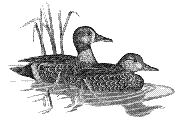United States Fish and Wildlife Service

Waterfowl Management Handbook
Date of this Version
January 1988
Abstract
A wide diversity of plants has adapted to the dynamic nature of wetlands. The continually changing floral landscape is shaped by physical or abiotic components that include climate, fire, soil, and water. Water quantity, quality, and chemistry have a dominating influence on wetlands as do factors such as hydroperiod (period when soils are saturated) and hydrological regime. Other factors that may affect the abundance, structure, and species composition of macrophytes or robust emergents are natural grazing, disease, and interspecific plant competition.
Vegetation is important to waterfowl for producing seeds, tubers, and browse; providing nest sites; and serving as substrates for animal foods. For example, the emergent marsh stage with the greatest number and diversity of birds has been called the “hemimarsh.” A maximum diversity and number of birds occur when vegetation cover and water interspersion in Type IV (semipermanent marsh) wetlands is at a 50:50 ratio. This wetland condition provides ideal nesting cover for waterbirds, as well as substrates and litter for invertebrate populations.
Emergent wetlands other than glacial marshes also require good interspersion of cover and water to attract waterfowl. Likewise, a diversity of wetland vegetation is much more desirable than a monoculture. As man expanded his activities in North America, the natural events producing mosaics of wetland vegetation were eliminated or altered. As an example, drainage or water diversion to enhance row crop production not only affects the immediate site, but often affects soil moisture conditions on adjacent areas as well.
This change in water availability influences plant species composition. Intensive cultivation for grains and forage, together with other human-related activities (water diversion projects, livestock grazing, and the elimination of natural fires) have modified the physical processes that influence the productivity of wetland systems. Managed areas throughout North America now must provide predictably good wetland habitat, despite modifications to water supplies, flooding regimes, and other physical factors.
Manipulation of wetland vegetation is a commonly employed tool. Although water-level manipulation is the traditional technique for modifying plant communities under intensively managed systems, other options include fire, grazing, and other physical and chemical disturbances. Values of vegetation structure and composition along with general concepts relating to manipulations are discussed.


Comments
Published in Diana H. Cross and Paul Vohs (eds.) Waterfowl Management Handbook. Fort Collins, CO: U.S. Fish and Wildlife Service, 1988. Online at http://www.nwrc.usgs.gov/wdb/pub/wmh/contents.html